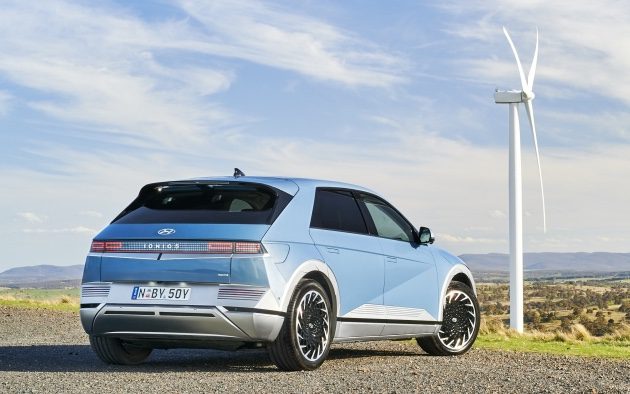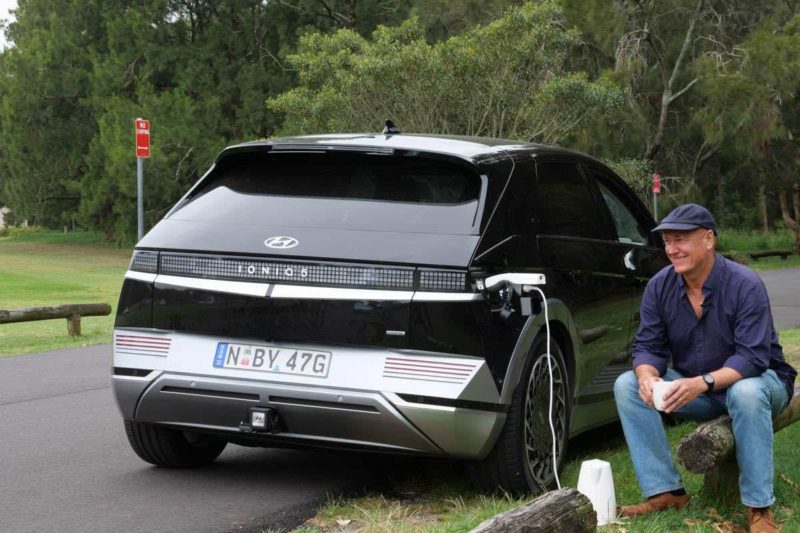There we were sitting in a park, boiling a kettle that was plugged into the Hyundai Ioniq 5 battery and then enjoying a freshly made cup of tea. Yes, it was mostly for show, and for the video we were shooting at the time. But it just rammed how quickly electric vehicles are taking us into a new world.
It’s fair to say that the Hyundai Ioniq 5 has been one of the most eagerly awaited electric cars to hit the market since the Tesla Model 3. It has bagged so many awards, including some highly respected car of the year prizes, and it’s the vehicle-to-load (V2L) technology, and the sense of space on the inside of this power station on wheels, that are the reason.
First to V2L. The “battery on wheels” concept is one that is often bandied about. And it’s true that electric cars will one day play a critical role in providing power and stability to a grid dominated by wind and solar. But we are probably a few years off that now, and the two-way interaction with the grid is complex and – at this stage – costly.
V2L is a simple work around. Hyundai has built an adaptor that you simply plug into the charging port, and away you go with a plug that looks, and works, like any in your house. It has capacity of 4.6kW, so it’s not just a kettle you can boil, but any number of appliances and tools that you might want to use remotely.

And, if the power does go out in your home, then you can simply plug in an extension cord and, in theory, you have probably got enough in a fully charged car battery to power the house for a few days, and possibly up to a week.
And, of course, you can take it camping, but for goodness sake please don’t bring the TV, or the party lights illustrated in one Hyundai commercials.
The second big win with this car is the sense of space. As we have noted on this website, Hyundai’s previous EV efforts – the Kona and the first Ioniq – have been pretty much petrol cars converted to an electric drivetrain.
The Ioniq 5 is the first of a series of new EV models designed from the ground up to be electric. So they’ve pushed out the wheels and flattened the floor to give a remarkable sense of space. As Bryce Gaton noted in his review, it really does feel like a Tardis.
The Ioniq 5 is described as a compact SUV, but I can’t remember a car interior with so much room. It would make a fantastic mobile office. There is a sun roof, with options for built-in solar PV if you really want it, and a compartment for storage and drink holders that moves back and forth.
The passenger and driver seats recline fully like one of those old business class seats, complete with raised leg rests. They say it gives a feeling of weightlessness. Let’s just call it very comfortable, and good for a snooze, or a sleep.
And this is just the start, the Kia brand which forms part of the Hyundai stable has already hinted at having seats that can turn to face the rear to create a lounge type effect. That hints at full autonomy and a whole new way of thinking about transport. We’ve only just started this journey.

And this is just the start, the Kia brand which forms part of the Hyundai stable has already hinted at having seats that can turn to face the rear to create a lounge type effect. That hints at full autonomy and a whole new way of thinking about transport. We’ve only just started this journey.
For now, the humans are at the wheel and in control. We first reviewed the Ioniq 5 back in May, when we were not allowed to take it on Australian road because it had yet to pass all the tests. It was a bit like reviewing a restaurant without trying the food. But now we have, and it’s good.
It’s a joy to ride. It doesn’t have the high level handling of, say, a Polestar 2 or a Model 3, around the same price range, but that’s because those are exceptional. The Ioniq 5 is merely very good. And it’s quiet. I didn’t detect much road noise.
The Ioniq 5 – with a 72kWh battery in the AWD model I was driving – is given a rated driving range of 460km. When I picked it up at Sydney for my week-long test drive the battery was 100 per cent charged and it suggested I could drive 400km.
I was heading to Canberra, and on this particular leg I probably got a little more than 300kms. That was to be expected – a highway at a constant speed of 110kms will drain a battery more quickly than city driving (it’s the reverse of petrol cars which do better on open roads than in the city). And to get to Canberra you do have to go uphill, and we were driving into a bit of a gale.
Still, the watt hours per kilometer of 22 seemed a little steep. That’s what I got out of the Porsche Taycan on my drive to Brisbane. But driving around Canberra the Ioniq 5 delivered an average 18wh/km, which would be bang on the 400km range it told me it would do on a full charge when I first picked it up.
On the drive back to Sydney, downhill and this time with a following breeze, the efficiency was just over 16wh/km, which took me closer to the official range rating of 460kms. But you can’t drive downhill for ever.

The Ioniq 5 is clearly a source of great interest. I’ve owned an EV for more than two years and been driving them regularly for longer, and this generated more looks, thumbs up and questions than any car since the first deliveries of the Model 3.
People wound down windows at traffic lights to ask about it, stood staring at it in car parks, and even left notes under the wipers offering a role in a TV commercial. And everyone within viewing distance was fascinated by the kettle plugged into the charging port.
Mostly, the attraction is because most people like SUVs, and the Ioniq 5 is the first SUV to arrive that’s not completely out of the ballpark in terms of price, and because it offers something different, and special.
Not everything about it is fantastic. It feels, at a starting price of $71,900 (2WD option), that it is still $10,000 or $20,000 more than most people feel they should be paying, although that is probably true of most EVs, particularly in Australia. But it also just outside the rebate territory for states like NSW, Victoria and South Australia.

It has four different options for re-generation. Level 1 for those who like to coast when they release the accelerator pedal, levels 2 and 3 who like tighter regeneration, and level 4, or “iPedal”, for those who want “one foot” driving and who don’t really want to push the brake unless it is really necessary.
All that is fantastic, but I was annoyed I had to select iPedal each time i got back into the car. The most it would offer was level 3. It was a minor annoyance, but for $75,000 up, you may want those sort of things to be “just so”.
Hyundai’s efforts to create space around the seats meant that the steering wheel is busy. There are a lot of different paddles and controls, and generally I found the whole presentation to be a bit too busy – and for a first-timer, a little unclear.
Granted, when I got delivery of my Model 3 I was glad I had already driven one, otherwise it would have been sitting in the driveway where the delivery truck left it for quite a while until I figured it all out.
But with the Ioniq 5, there always seemed to be one other button to push. Often I thought it was switched on and ready to go, but it wasn’t. Ditto when I thought it was switched off and ready to leave.
Even the charging port threw me. I pulled up at an NRMA charging station, and having owned an EV for two years and driven more than a dozen different models, I thought “I can do this”.
I pushed and prodded at the port, but nothing happened. I pushed the button on the key. I looked for a button on the dash. I Googled it, I you-tubed it, I rang my son. I went to manual and it said, push harder. I went back and it opened. The only thing I thought I seemed to do differently was to swear at it. Maybe they should add that into the manual.
Even after a week, the charging port didn’t always open as easily as I would expect. Not a big deal in the great scheme of things, but something for the team to work on – along with making improvements to the navigation and to the radio. At the end of the week, I still hadn’t worked out how to tune to the ABC. But I guess, when you do work it out, you wonder why it was ever a problem in the first place.
All in all, this was a very pleasurable week of driving. My 92 year old mum loved the space in the passenger seat. My adult children both thought it was a fantastic car, if out of their price range.
And after feeling like I was on a really bad first date in the first few hours of struggling with the radio, the charging port and other controls, I decided that this was, indeed, a damn fine car.
Like the Tesla, it’s a step into the future. The sense of space is something to behold. And I desperately want a car with vehicle to load. That really is going to be the next big thing.
The only problem is, the limited first offerings of the Ioniq 5 in Australia have already sold out, and the second offering may not be available until around June next year. See video below for more about this problem: Video: Australians want EVs, but finding one to buy is not so easy


Giles Parkinson is founder and editor of The Driven, and also edits and founded the Renew Economy and One Step Off The Grid web sites. He has been a journalist for nearly 40 years, is a former business and deputy editor of the Australian Financial Review, and owns a Tesla Model 3.

